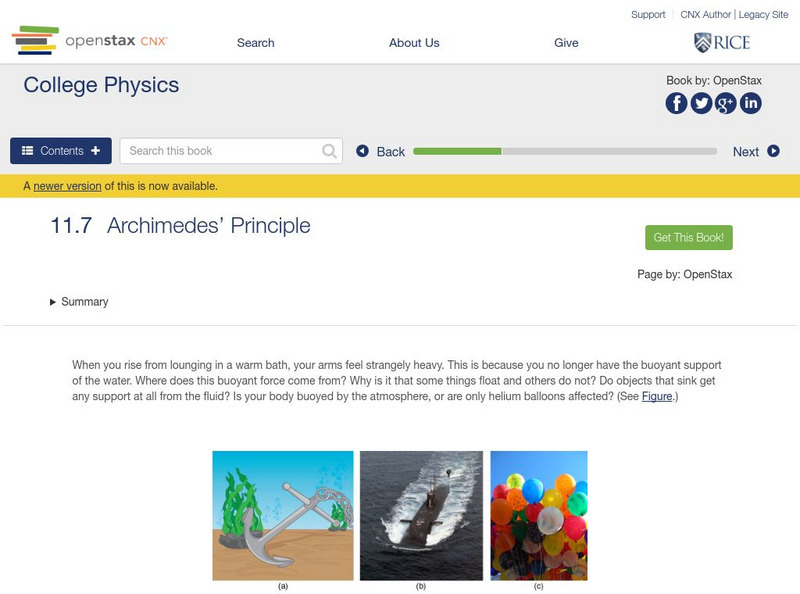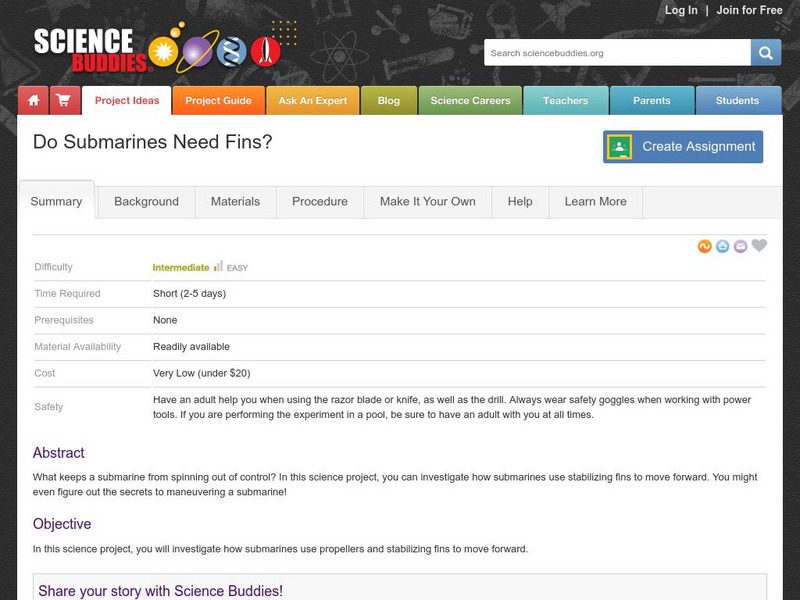TeachEngineering
Teach Engineering: Fluid Power Basics
Students learn about the basic fundamental concepts regarding fluid power, which includes both pneumatic, which utilize gas, and hydraulic, which utilize liquid, systems. Both systems contain four basic components: a reservoir, a pump or...
TeachEngineering
Teach Engineering: How a Faucet Works
Students learn about the underlying engineering principals in the inner workings of a simple household object - the faucet. Students use the basic concepts of simple machines, force and fluid flow to describe the path of water through a...
Alabama Learning Exchange
Alex: Building a Paper Airplane Using Bernoulli's Principle
This is a culmination activity used after middle schoolers have studied Bernoulli's Principle as part of a unit on forces and fluids. Students will use the Internet, textbooks, library resources and their cooperative learning group to...
Exploratorium
Exploratorium: Science Snacks: Balancing Ball: Suspend a Ball in a Stream of Air
In this lesson plan students learn about air flow using a suspended ball in an air stream.
Science Education Resource Center at Carleton College
Serc: Buoyant Force
In this Physics lab, students learn about Archimedes' Principle. An object is submerged in water and vegetable oil and the buoyant force and height are measured at different levels. The slope of the graph Buoyant Force vs. Height is the...
OpenStax
Open Stax: Physics: Archimedes' Principle
From a chapter on Fluid Statics in a Physics textbook. This section of the chapter provides a detailed discussion of Archimedes' principle, buoyant force, floating and sinking, and the role of density. Includes questions, problems and...
TeachEngineering
Teach Engineering: Rock and Boat
Students observe Archimedes' principle in action in this challenge where a toy boat is placed in a container of water and a rock is placed on the floating boat. Students must explain why the water level rises/falls/stays the same based...
TeachEngineering
Teach Engineering: Next Generation Surgical Tools in the Body
Through this unit, students act as engineers who are given the challenge to design laparoscopic surgical tools. After learning about human anatomy and physiology of the abdominopelvic cavity, especially as it applies to laparoscopic...
TeachEngineering
Teach Engineering: Floating and Falling Flows
Students discover fluid dynamics related to buoyancy through experimentation and optional photography. Using one set of fluids, they make light fluids rise through denser fluids. Using another set, they make dense fluids sink through a...
Physics Aviary
Physics Aviary: Practice Problems: Pascal's Principle Problem
Students must determine the force required to hold a syringe in place when a second force is trying to get it to move.
TeachEngineering
Teach Engineering: Too Much Pressure!
In this activity, students learn how engineers design faucets. Students will learn about water pressure by building a simple system to model faucets and test the relationship between pressure, area and force. This is a great outdoor...
Concord Consortium
The Concord Consortium: Molecular Workbench: Hydraulic Lever
Adjust the amount of force in this simulated piston to observe how the fluid in this system is affected.
OpenStax
Open Stax: Pressure
From a chapter on Fluid Statics in a Physics textbook. This section of the chapter defines pressure and how it relates to force, as well as how to find the amount of force given area and pressure. Includes questions, problems and...
Other
Metamorphic Rocks [Ppt]
Explains the different ways that metamorphic rocks can form. Looks at high temperature, high pressure, and chemically active fluids. Discusses structures created in metamorphic rocks by different forces and the classifications based on...
Science Buddies
Science Buddies: Do Submarines Need Fins?
In this science project, you can investigate how submarines use stabilizing fins to move forward. Exploring friction and buoyant force you will get closer to understanding how these large ships function. Research resources are included...
Massachusetts Institute of Technology
Mit: Open Course Ware: Buoyancy
Students explore buoyancy. Some topics examined in the activities are buoyant force, stability of floating objects, and Archimedes' principle. The resource consists of video clips, lecture notes, practice problems, and exam questions....
TeachEngineering
Teach Engineering: Density Rainbow and the Great Viscosity Race
Students explore the densities and viscosities of fluids as they create a colorful 'rainbow' using household liquids. While letting the fluids in the rainbow settle, students conduct 'The Great Viscosity Race,' another short experiment...
NASA
Nasa: What Is Lift?
A description of how lift is a mechanical force that requires a fluid moving through a solid object and a change in velocity.
Libre Text
Libre Text: Geostrophic Balance
Geostrophic balance is arguably the most central concept in physical oceanography and dynamical meteorology. A key feature of geostrophic balance is that rather than flowing from high to low pressure, the fluid actually moves parallel to...
Exploratorium
Exploratorium: Snacks
Exploratorium's snacks aren't edible, but they are good! Use your science skills to discover gravity, learn about biology, do fun experiments.


















